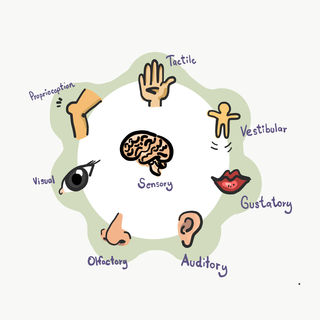Embrace Their World: A Parent’s Guide to Sensory Sensitivity and ADHD
Welcome to the vibrant world of parenting a child with ADHD and sensory sensitivity! Understanding your child’s unique needs can be a delightful journey, and we’re here to help you every step of the way.
Understanding Sensory Sensitivity in Children with ADHD
Is your child easily overwhelmed by loud noises, strong smells, or scratchy clothing? They might be experiencing sensory sensitivity, a common sidekick of Attention Deficit Hyperactivity Disorder (ADHD). But fear not! This comprehensive guide will unwrap the layers of sensory sensitivity, offering you the knowledge and tools to support your little one’s extraordinary senses.
What is Sensory Sensitivity?
Sensory sensitivity is like having a super-powered sensory system where one or more of the senses – hearing, sight, smell, touch, taste, or the internal senses of body awareness and motion – are dialed up to eleven. Children with sensory sensitivity may find ordinary stimuli intense or even painful, leading to what we might see as overreactions. But for them, it’s all too real.
The Connection Between Sensory Sensitivity and ADHD
Many parents wonder why sensory sensitivity seems to walk hand-in-hand with ADHD. The answer? Both involve the nervous system’s processing of information. ADHD impacts attention, focus, and impulsivity, while sensory sensitivity involves the processing of sensory input. The two can interact in ways that make the world a challenging place for your child. But with love and understanding, you can transform this challenge into an adventure.
Signs and Symptoms of Sensory Sensitivity in Kids with ADHD
Moments like recoiling from a hug or meltdown at the sound of a vacuum cleaner could be signs that your child is dealing with sensory sensitivity. By recognizing these signs, you’ll be one step closer to crafting a comfortable space for your child:
- Extreme reactions to certain textures, sounds, or lights
- Difficulty with balance or spatial orientation
- Being easily distracted by background noises or movements
- Preference for certain foods based on texture rather than taste
Next Steps: Embracing Your Child’s Sensory Needs
Understanding is just the beginning. Next, we’ll explore strategies to help your child navigate their sensory experiences, how to create sensory-friendly environments, and ways to communicate with teachers and caregivers. With patience and creativity, you’ll be able to support your child in a way that honors their individual needs and promotes growth and learning.
Let’s embark on this enlightening path together, helping our children to thrive in a world that shines brightly – sometimes a little too brightly for their exquisite senses. Stay tuned for our next segment, where we’ll delve deeper into practical, hands-on strategies for managing sensory sensitivity in children with ADHD.

Embracing Their World: A Comprehensive Guide for Parents on Sensory Sensitivity and ADHD
Embarking on the parenting journey with a child who has ADHD and sensory sensitivity can be like navigating a kaleidoscope of experiences. Let’s dive into a colorful array of information and tools to enhance this beautiful, if sometimes bewildering, adventure.
Five Essential Insights for Preparing for Sensory Sensitivity and ADHD
Before plunging into the nitty-gritty of sensory sensitivity, it’s crucial to have your parenting toolkit ready. Here are five things every parent should know to prepare for the sensory sensitivity journey with their ADHD child:
- Knowledge is Comfort: Equip yourself with understanding. Sensory sensitivity can impact how children interpret and react to sensory information. Knowing the whys and hows can help you anticipate and address your child’s needs.
- Patient Observation: Become a detective in your child’s life. Observe their reactions and look for patterns in their behavior. Understanding triggers can lead to proactive solutions.
- Embrace Flexibility: Routines are beneficial, but rigidity can be counterproductive. Stay flexible and adapt to your child’s needs, knowing that what works today may need adjustment tomorrow.
- Create a Sensory-Safe Haven: Your home should be a place of comfort. Designate a sensory-safe spot where your child can retreat and decompress when the outside world becomes too overwhelming.
- Communication is Key: Foster open dialogue with your child, their educators, and healthcare providers. It’s a collaborative effort to provide an environment where your child can flourish.
Strategies to Support Your Child With Sensory Sensitivity and ADHD
Parenting is an art and a science, especially when your canvas is the vibrant soul of a child with sensory sensitivity and ADHD. Here are some practical strategies to paint a harmonious life for your child:
- Customize Sensory Experiences: Tailor the sensory input in your child’s environment. Soft lighting, calm colors, and noise-cancellation headphones can make a remarkable difference.
- Integrate Sensory Breaks: Build short, frequent sensory breaks into your child’s daily routine. These moments of respite can prevent sensory overloads and keep your child centered.
- Adopt Sensory Diets: Work with an occupational therapist to create a ‘sensory diet’—a personalized activity plan that provides the sensory input your child needs to stay balanced throughout the day.
- Maintain Open Dialogue: Talk with your child about their sensory experiences. When they’re involved in finding solutions, they’ll feel empowered and understood.
- Advocate for Accommodations: Work with your child’s school to implement accommodations that can facilitate their learning. It might include wearing a weighted vest, using fidget tools, or having a quiet space available.
Crafting a Sensory-Friendly World at Home and Beyond
Creating a world that respects and responds to your child’s sensory needs may seem like a tall order, but with creativity and a dash of fun, you can cultivate a sensory-friendly landscape both at home and in public. Consider these actionable tips:
- De-clutter and Organize: A tidy and predictable space can reduce sensory stimuli and promote a sense of calm.
- Sensory-Smart Shopping: Opt for clothing and products designed with sensory sensitivities in mind, like tagless shirts or seamless socks.
- Engage with Nature: Nature provides a bountiful sensory environment that can be soothing. Encourage your child to play outside, dig in the dirt, or simply lay in the grass to experience grounding natural sensations.
- Sensory-Sensitive Events: Look out for sensory-sensitive events in your community, such as movie screenings with lower volume and lights, or quiet hours at museums and play centers.
- Be an Informed Advocate: Educate family, friends, and your community about sensory sensitivity. Awareness fosters understanding and acceptance.
See more great Things to Do with Kids in New Zealand here. For more information see here
Disclaimer
The articles available via our website provide general information only and we strongly urge readers to exercise caution and conduct their own thorough research and fact-checking. The information presented should not be taken as absolute truth, and, to the maximum extent permitted by law, we will not be held liable for any inaccuracies or errors in the content. It is essential for individuals to independently verify and validate the information before making any decisions or taking any actions based on the articles.




